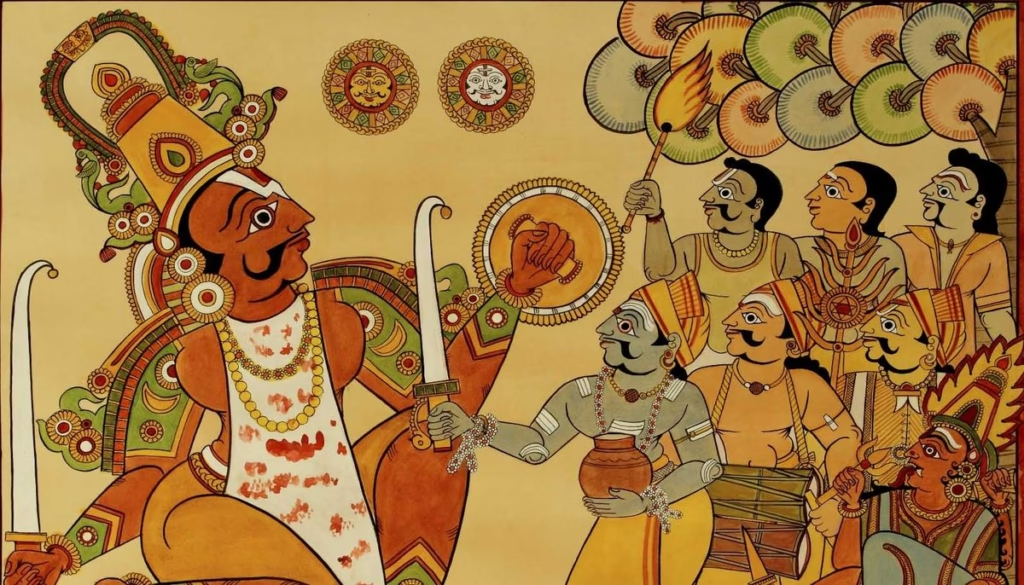
Hey readers, welcome to our blog. Here you can step into the world of Maharashtra’s Chitrakathi Art, where stories don’t just stay in books; they walk, talk, sing, and most importantly, paint themselves into your heart!
This ancient art form isn’t just a drawing on paper; it’s a mix of painting, music, and storytelling, all rolled into one magical performance. Long before Netflix and audiobooks, villagers would gather under a tree or in a temple courtyard, and a Chitrakathi (storyteller-artist) would unfold story panels while singing tales from epics like Ramayana and Mahabharata. Think of it as an ancient slideshow, powered by human voice and hand-painted art. No charging needed; just claps and some snacks!
But sadly, time hasn’t been kind. From over 162 Chitrakathi families in the 1980s, today only 8–10 families actively practice this art in regions like Pingsut village (Sindhudurg) and Pawara community (Maharashtra).
And yet, this fading art still shines like an old photo, slightly yellowed, but full of stories waiting to be told.
What is Chitrakathi?
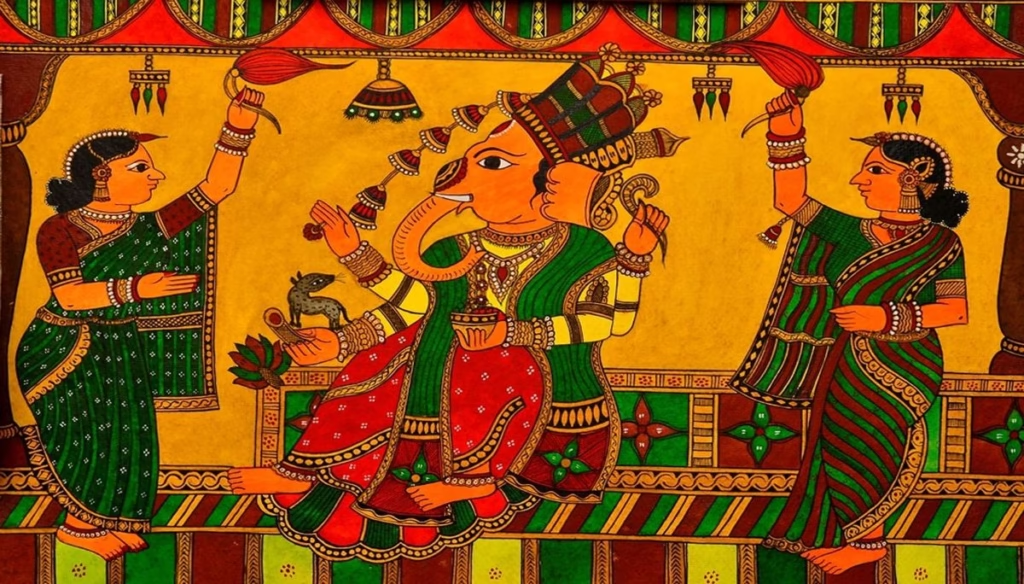
A Story + Picture + Song = Chitrakathi!
Let’s break it down! The word “Chitrakathi” is made from two simple words:
- Chitra means picture
- Katha means story
So, a Chitrakathi is someone who tells a story using pictures. Yes, it’s that simple, and totally magical!
Now imagine this: a time before mobile phones, tablets, or even electricity. No Netflix, no YouTube, not even a radio. But guess what people did for fun? They gathered around to listen to a Chitrakathi. He would bring a bunch of hand-painted pictures, sometimes tied together like a scroll, and tell stories—often from epics like the Ramayana or Mahabharata. And here’s the fun part—he didn’t just talk. He sang, used music, and even changed his voice to act out characters! It was like a live movie, but way more personal.
Think of it as the original PowerPoint presentation, but with more emotions, no laptops, and a whole lot of soul. Plus, no chance of “technical errors”—unless the wind blew away a painting!
Chitrakathi is not just art; it’s a beautiful combo of storytelling, singing, and painting. It connects people, teaches lessons, and keeps old tales alive. It’s like a storyteller, an artist, and a singer—all rolled into one person. Pretty cool, right?
So next time someone says “ancient art is boring,” show them Chitrakathi—and watch their jaw drop!
Why Is This Art Important Today
Old Stories, New Lessons: Why Chitrakathi Still Matters
In today’s fast world of swipe, scroll, and skip ads, we’re losing something important—our connection to stories that shaped us. This is where Chitrakathi comes in like a superhero from the past. This ancient art form doesn’t just show pretty pictures; it teaches values, culture, and history—all in one colorful package!
Kids today may know all Marvel heroes, but do they know about Hanuman’s loyalty or Rama’s patience? Chitrakathi keeps these timeless tales alive—not through books or boring lectures, but through songs, vibrant drawings, and dramatic storytelling. It’s like a cultural time machine with better music!
And here’s the reality check:
- India has over 3,000 traditional art forms, and many are vanishing
- Only a handful of Chitrakathi artists remain, mostly elderly, mostly unheard
- With more than 85% of youth glued to digital content, the art faces extinction unless revived
But there’s hope. With schools, art festivals, and digital media taking interest, Chitrakathi is slowly stepping into the modern world, sometimes even on YouTube!
The Origins of Chitrakathi: Where Art Meets Mythology
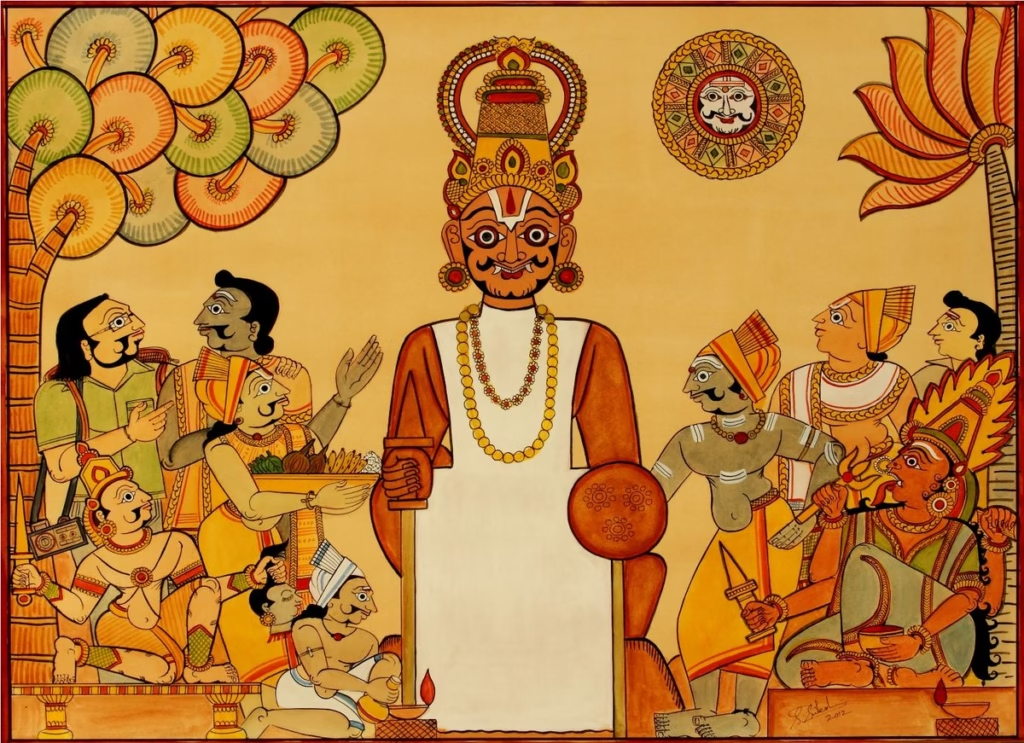
Let’s travel back in time—way before smartphones, social media, or even school textbooks existed. Imagine a world where stories were shared not by scrolling a screen, but by singing and showing hand-painted pictures. That magical world still lives on in a small but culturally rich village called Pinguli, tucked near Sindhudurg in the lush green state of Maharashtra.
Now, Pinguli might look like just another peaceful village, perfect for a relaxing holiday—but don’t let its calm nature fool you! This place is bursting with heritage and creativity. It holds the roots of Maharashtra’s Chitrakathi Art, a rare and ancient storytelling form that blends colorful paintings with traditional songs and folk tales. Here, stories of gods, demons, mighty warriors, and clever tricksters were not just told—they were performed.
In Maharashtra’s Chitrakathi Art, storytellers use a series of hand-painted pictures called “pothis” to walk the audience through epic adventures, mythological tales, and moral lessons. Think of it as ancient India’s version of a live-action comic book, but way cooler! Each scene is drawn with incredible care, using bright natural colors, handmade paper, and deep emotions. But instead of speech bubbles, the artist sings the story out loud, making the audience feel every twist and turn.
What’s even more fascinating? This tradition was carried forward for hundreds of years by a special tribal community called the Thakar tribe. They weren’t just artists; they were the village’s movie directors, musicians, teachers, and even spiritual guides. Wherever they went, stories followed.
Chitrakathi isn’t just art. It’s emotion, history, and culture rolled into one beautiful performance. In a time when everyone is swiping on screens, Pinguli’s timeless tales remind us that some of the best stories are the ones painted by hand and told straight from the heart.
- The roots in Maharashtra’s Pinguli village
Tucked away in the lush green corners of Sindhudurg district, Pinguli may be a small village, but it has a big story to tell; literally. This peaceful patch of Maharashtra is the proud birthplace of Chitrakathi art, a tradition older than electricity and far more colorful than your Instagram feed.
Why Pinguli? Well, it sits at the meeting point of royal influence, tribal culture, and folk spirituality. Kings once supported the art form, and villages welcomed these storytellers like today’s viral influencers!
Key Facts about Pinguli:
- Located in the Sindhudurg district, near the Goa border
- Home to under 5,000 people, but rich in heritage
- Chitrakathi art here dates back over 300–400 years
- Paintings are made using natural dyes, handmade paper, and bamboo brushes
- One Chitrakathi performance can include 40–50 hand-painted frames (pothis)
And guess what? Even today, Pinguli’s name is closely tied to this living art, making it the “Chitrakathi Capital” of India (unofficially, but we think it deserves the crown!).
- The Thakar Tribal Community and Their Storytelling Role
Meet the Thakar tribe—the original content creators of Maharashtra, centuries before hashtags and trending reels were a thing! While we’re busy scrolling on phones, these folks were literally scrolling—unfolding hand-painted story sheets while performing epic tales from the Ramayana, Mahabharata, and more. Think of them as the earliest version of a live podcast, but with better costumes, emotional expressions, and definitely more singing! No need for mics or editing software—just a powerful voice, a dramatic pause, and a painted scene that did all the storytelling. These artists were the vocal, visual, and viral sensation of their time, sans Wi-Fi but full of wow!
The Thakar Tribe at a Glance:
- A tribal community that has practiced Chitrakathi for generations
- Traditionally traveled to villages to perform epic tales like the Ramayana and the Mahabharata
- Storytellers doubled as singers, narrators, painters, and moral teachers
- Today, 20–25 Thakar families are actively involved in Chitrakathi
- Some are even taking their work digital through websites, social media, and online workshops
While some Thakars have adapted with the times, many are still preserving the age-old methods, reminding us that sometimes the best stories don’t come from screens, but from the soul.
How Chitrakathi Art is Made: From Brush to Performance
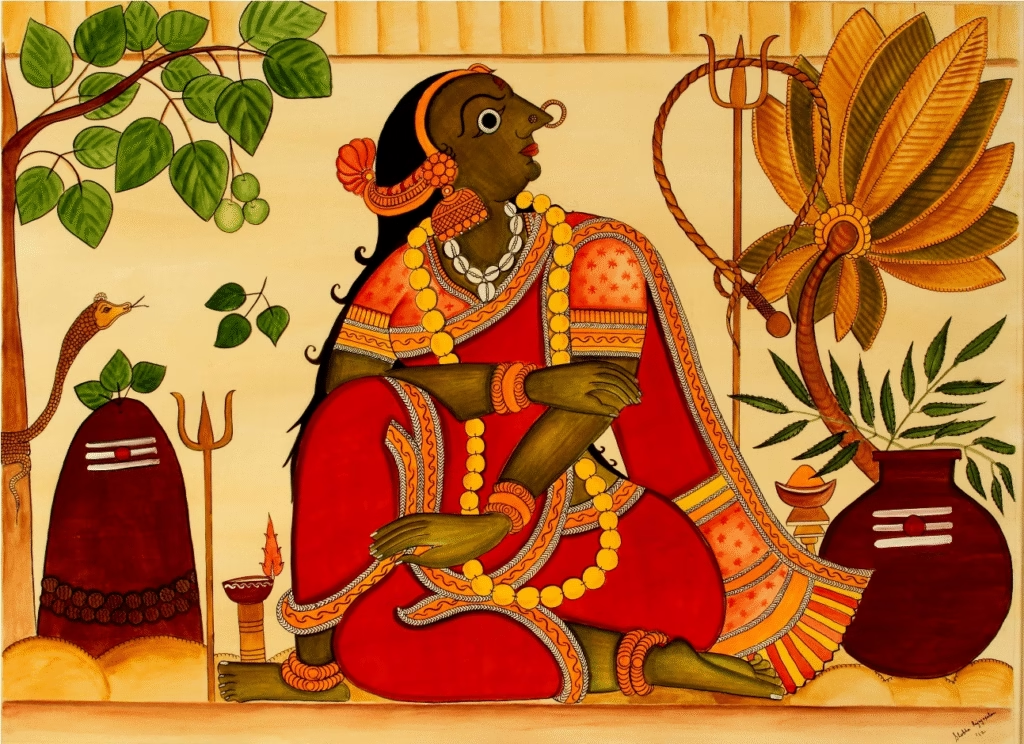
Ever wondered how stories come alive without animations or fancy CGI? Welcome to the magical process behind Maharashtra’s Chitrakathi Art, where everything is made by hand—and heart!
It all starts with raw, earthy materials. No synthetic colors or mass-produced canvas here. This art is as organic as your grandma’s pickles!
- Materials Used and Traditional Techniques
The process may seem simple, but it’s full of care, skill, and tradition passed down through generations.
Here’s what goes into making a single Chitrakathi painting:
- Paper: Handmade, usually from recycled cotton or tree bark
- Colors: Natural dyes from vegetables, flowers, stones, and soot (yes, soot!)
- Brushes: Made from bamboo sticks and squirrel or goat hair
- Fixing: After painting, the sheets are dried under the sun and stored carefully in bundles called “pothis”
Each frame takes anywhere from 1 to 3 days to complete, depending on the detail. A full set of story scrolls can take up to 2–3 months!
- The Storytelling Method: Singing and Showing Pictures
Now comes the performance part, where the paintings come to life! Unlike silent art hanging on walls, Maharashtra’s Chitrakathi Art literally speaks (well, sings!).
The storyteller sings ancient tales, flipping through each frame one by one, matching the emotion and rhythm of the story.
Here’s how it works:
- The artist narrates or sings the story in Marathi or local dialects
- As they sing, they show each picture frame in sync with the lyrics
- Instruments like the ektara, tabla, and manjeera add music to the tale
- The audience sits around, fully hooked; sometimes even joining in!
A traditional Chitrakathi session lasts 30 to 60 minutes, depending on the story. And honestly, it’s more entertaining than many movie nights!
In a world of fast content, Chitrakathi teaches us that slow and soulful still wins hearts.
Themes and Tales in Chitrakathi
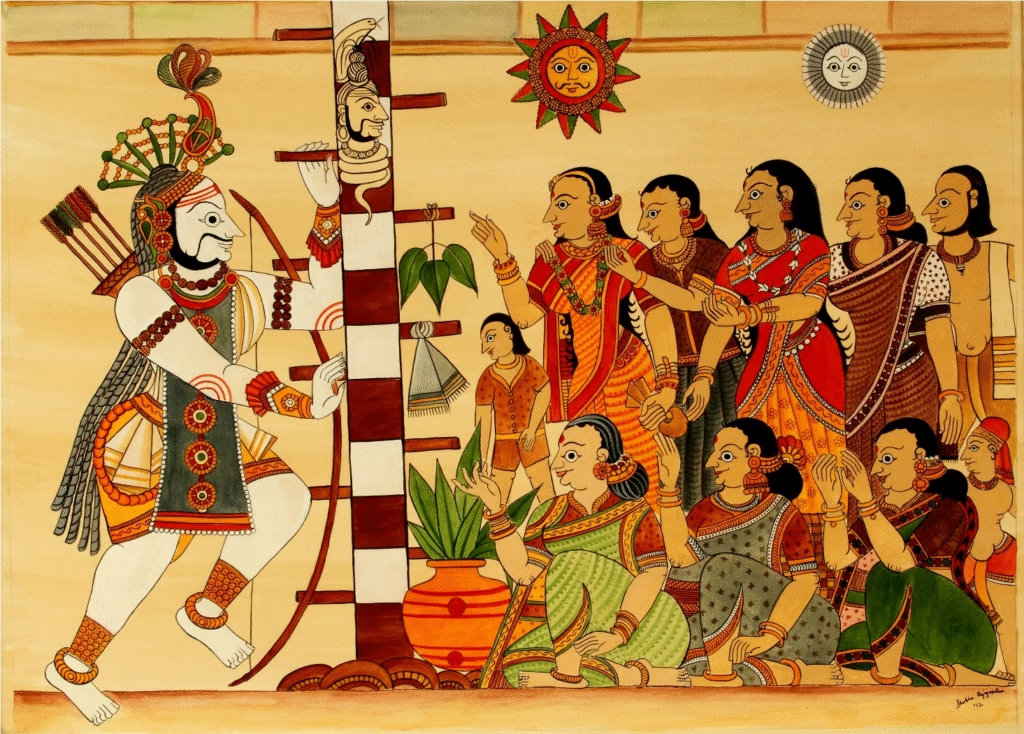
Ever seen a painting that tells a whole story, from the villain’s entry to the happy ending? That’s what makes Chitrakathi so special. It’s not just pretty art; it’s a complete desi drama with heroes, villains, moral lessons, and the occasional flying monkey.
Maharashtra’s Chitrakathi Art draws inspiration from two of India’s biggest blockbusters, the Ramayana and the Mahabharata. And believe it or not, these tales are still going strong after thousands of years. Who needs Netflix when you’ve got Lord Rama, Sita, Ravana, and Hanuman flipping through illustrated frames?
- Popular Stories from the Ramayana and Mahabharata
The core of Chitrakathi revolves around timeless epics that never go out of style:
Ramayana: Stories of Lord Rama, Sita, Lakshmana, and Hanuman. Especially popular? The battle with Ravana and the building of the bridge to Lanka (yes, that one!).
Mahabharata: Scenes like the Kurukshetra war, Krishna’s teachings, and the game of dice are performed with emotional depth and lively visuals.
- Each epic tale is split into 40 to 50 hand-painted frames, taking audiences on a journey of good vs. evil, loyalty, betrayal, and dharma.
These stories teach life lessons and values, without ever sounding like a lecture!
- Local Legends and Folk Heroes Brought to Life
But wait, it’s not just the “big names.” Chitrakathi also celebrates regional legends, folk heroes, and even ghost stories (yep, complete with spooky sound effects!).
Some beloved local themes include:
- Folk tales of King Shivaji and his brave warriors
- Tales of ghosts and spirits that taught kids not to wander at night (basically early desi horror)
- Stories of everyday heroes: farmers, village women, or animals that taught kindness and courage
These tales are often passed down orally and vary by region. According to researchers, over 70+ folk stories have been illustrated and performed in the Chitrakathi style.
So whether it’s a divine epic or a village rumor-turned-fable, Chitrakathi makes sure every story gets its moment in the spotlight; with colors, songs, and heart.
The Decline of a Rich Tradition
Once upon a time, Maharashtra’s Chitrakathi Art was the talk of the town; literally. Villages would gather around, waiting to hear epic tales sung by storytellers with hand-painted scrolls. But today? Those scrolls are gathering dust while the world scrolls through phones instead.
Let’s face it; between binge-worthy web series, 10-second Reels, and talking AI bots (ahem), traditional art forms like Chitrakathi are struggling to stay relevant. It’s like trying to play a flute in a rock concert. People love the idea of Chitrakathi… they just don’t show up for the performances anymore.
- Why Fewer People Are Practicing Chitrakathi
Many of the younger generation from the Thakar tribe are now choosing more secure jobs like driving, farming, or working in factories. After all, art is beautiful, but it doesn’t always pay the electricity bill.
Here’s what the numbers say:
- Only about 15–20 families in Pinguli still practice Chitrakathi today
- Younger artists are dropping out due to a lack of income and recognition
The average age of active Chitrakathi artists is now 50+ years, showing a clear generational gap
Without proper government support, buyers, or regular performance spaces, many artists are forced to let go of the brush and pick up other work just to survive.
- The Challenge of Modern Entertainment
Let’s be honest; when you’re up against YouTube, Netflix, and mobile games with dragons and zombies, even Lord Rama needs a marketing team! Chitrakathi isn’t just competing with technology; it’s also battling short attention spans and fast lifestyles.
Many artists are now trying to adapt:
- Sharing their art on social media
- Hosting workshops at schools and museums
- Selling scrolls as decorative art to tourists
But it’s a slow climb. And while the world moves faster every day, Chitrakathi reminds us to slow down and enjoy a story told by hand, heart, and heritage.
Revival Through Digital Tools and Modern Support
Just when it looked like Maharashtra’s Chitrakathi Art was fading into silence, the internet gave it a second chance; yep, the same place where cat videos and viral dance trends rule the screen is now helping bring ancient stories back to life!
Who would’ve thought a tradition that began in dusty villages with scrolls and singing would find its next audience on YouTube and Instagram? Well, that’s exactly what’s happening. Today, artists are going digital, and we’re here for it!
- Online Performances, YouTube & Social Media
From huts to hashtags, Chitrakathi is now reaching the global stage. Artists are uploading performances, behind-the-scenes painting videos, and even “How to Make Natural Colors” tutorials online.
Digital Revival by the Numbers:
- Over 30 Chitrakathi videos are now available on YouTube
- Pages dedicated to Chitrakathi have gained thousands of followers across platforms like Instagram and Facebook
- Online workshops conducted by artists now draw global art lovers; from Mumbai to Melbourne!
Even kids are joining in. Some Thakar families say their grandchildren now help them edit videos and manage online sales. Talk about a traditional meeting with Gen Z!
Efforts by Artists and Organizations to Preserve the Art
Thankfully, it’s not just the internet trying to rescue ancient traditions with hashtags and filters. Many passionate artists, NGOs, and cultural institutions are rolling up their sleeves to preserve Maharashtra’s Chitrakathi Art, and they’re not just doing it for the gram! From organizing folk art festivals and interactive workshops to setting up rural art museums and school outreach programs, these groups are working hard to keep the brush moving and the stories alive.
Artists are also taking to digital platforms to showcase their work, while government bodies and private collectors are offering grants and buying artwork. Slowly but surely, these efforts are giving Chitrakathi the spotlight it deserves, one painted tale at a time.
Key Preservation Efforts:
- Museums and cultural centers like the Crafts Museum (Delhi) and the Tribal Museum (Pune) now exhibit Chitrakathi scrolls
- NGOs and art schools are conducting artist residencies and scholarships for Chitrakathi practitioners
- Workshops and live storytelling events are organized at schools, colleges, and festivals
Some state support has also begun trickling in; but artists say they need more. After all, reviving ancient art with modern tools is cool, but it still needs consistent support (and WiFi that doesn’t buffer mid-story!).
Chitrakathi is no longer just a dying tradition; it’s a digital warrior in a new era of storytelling.
Final Takeaway
Now you know all about Maharashtra’s Chitrakathi Art; how it was made, what stories it told, and why it is so special. This art may not have fancy cartoons or video game effects, but it has something better: real hands, real hearts, and real stories passed down for many, many years.
Even today, some artists are trying hard to keep this beautiful art alive. They are sharing videos online, painting new stories, and teaching others. But they need our help too!
So, next time you see a Chitrakathi picture or hear about this art, don’t scroll away. Watch it, share it, talk about it. It’s a treasure from our past; and we should protect it like a favorite toy or a sweet memory.
Let’s all work together to make sure Maharashtra’s Chitrakathi Art keeps shining brightly for many more years!
You may check out our Blog Page on Traditional Indian art.

Leave a Reply